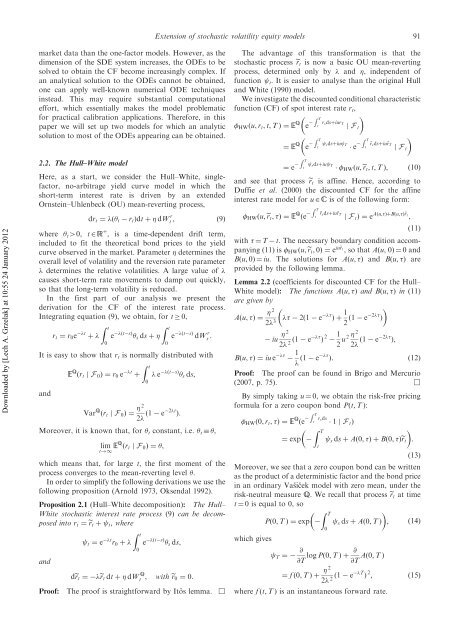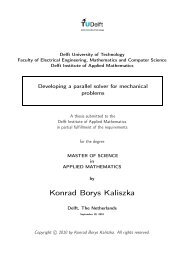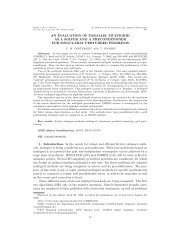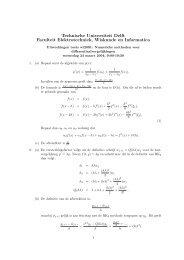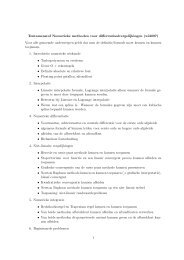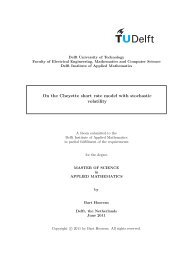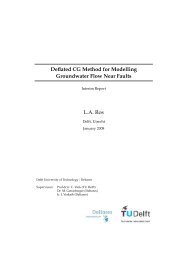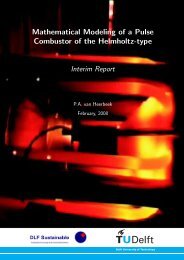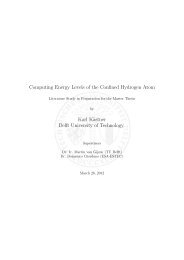Extension of stochastic volatility models with Hull-White interest rate ...
Extension of stochastic volatility models with Hull-White interest rate ...
Extension of stochastic volatility models with Hull-White interest rate ...
Create successful ePaper yourself
Turn your PDF publications into a flip-book with our unique Google optimized e-Paper software.
<strong>Extension</strong> <strong>of</strong> <strong>stochastic</strong> <strong>volatility</strong> equity <strong>models</strong> 91Downloaded by [Lech A. Grzelak] at 10:55 24 January 2012market data than the one-factor <strong>models</strong>. However, as thedimension <strong>of</strong> the SDE system increases, the ODEs to besolved to obtain the CF become increasingly complex. Ifan analytical solution to the ODEs cannot be obtained,one can apply well-known numerical ODE techniquesinstead. This may require substantial computationaleffort, which essentially makes the model problematicfor practical calibration applications. Therefore, in thispaper we will set up two <strong>models</strong> for which an analyticsolution to most <strong>of</strong> the ODEs appearing can be obtained.2.2. The <strong>Hull</strong>–<strong>White</strong> modelHere, as a start, we consider the <strong>Hull</strong>–<strong>White</strong>, singlefactor,no-arbitrage yield curve model in which theshort-term <strong>interest</strong> <strong>rate</strong> is driven by an extendedOrnstein–Uhlenbeck (OU) mean-reverting process,dr t ¼ ð t r t Þdt þ dW rt ,ð9Þwhere t 40, t 2 R þ , is a time-dependent drift term,included to fit the theoretical bond prices to the yieldcurve observed in the market. Parameter determines theoverall level <strong>of</strong> <strong>volatility</strong> and the reversion <strong>rate</strong> parameter determines the relative volatilities. A large value <strong>of</strong> causes short-term <strong>rate</strong> movements to damp out quickly,so that the long-term <strong>volatility</strong> is reduced.In the first part <strong>of</strong> our analysis we present thederivation for the CF <strong>of</strong> the <strong>interest</strong> <strong>rate</strong> process.Integrating equation (9), we obtain, for t 0,r t ¼ r 0 e t þ Z te ðt0sÞ s ds þ Z t0e ðt sÞ dW r s :It is easy to show that r t is normally distributed <strong>with</strong>andE Q ðr t jF 0 Þ¼r 0 e t þZ t0 e ðtsÞ s ds,Var Q ðr t jF 0 Þ¼ 22 ð1 e 2t Þ:Moreover, it is known that, for t constant, i.e. t ,limt!1 EQ ðr t jF 0 Þ¼,which means that, for large t, the first moment <strong>of</strong> theprocess converges to the mean-reverting level .In order to simplify the following derivations we use thefollowing proposition (Arnold 1973, Oksendal 1992).Proposition 2.1 (<strong>Hull</strong>–<strong>White</strong> decomposition): The <strong>Hull</strong>–<strong>White</strong> <strong>stochastic</strong> <strong>interest</strong> <strong>rate</strong> process (9) can be decomposedinto r t ¼ er t þ t , whereandPro<strong>of</strong>:t ¼ e t r 0 þ Z te ðt0sÞ s ds,der t ¼ er t dt þ dW Q t , <strong>with</strong> er 0 ¼ 0:The pro<strong>of</strong> is straightforward by Itoˆs lemma. œThe advantage <strong>of</strong> this transformation is that the<strong>stochastic</strong> process er t is now a basic OU mean-revertingprocess, determined only by and , independent <strong>of</strong>function t . It is easier to analyse than the original <strong>Hull</strong>and <strong>White</strong> (1990) model.We investigate the discounted conditional characteristicfunction (CF) <strong>of</strong> spot <strong>interest</strong> <strong>rate</strong> r t ,R T HW ðu, r t , t, T Þ¼EeQ r s dsþiur Tt jF tR TR T¼ EeQ sdsþiu T ~rt es dsþiu~r Tt jF tR Ttsdsþiu¼ eT HW ðu,er t , t, T Þ, ð10Þand see that process er t is affine. Hence, according toDuffie et al. (2000) the discounted CF for the affine<strong>interest</strong> <strong>rate</strong> model for u 2 C is <strong>of</strong> the following form:R Tt HW ðu,er t , Þ ¼E Q ~rðes dsþiu~r TjF t Þ¼e Aðu,ÞþBðu,Þ~r t,ð11Þ<strong>with</strong> ¼ T t. The necessary boundary condition accompanying(11) is HW ðu,er t ,0Þ¼e iu~r t, so that A(u, 0)¼ 0 andB(u,0)¼ iu. The solutions for A(u, ) and B(u, ) areprovided by the following lemma.Lemma 2.2 (coefficients for discounted CF for the <strong>Hull</strong>–<strong>White</strong> model): The functions A(u, ) and B(u, ) in (11)are given byAðu, Þ ¼ 2 2 3 2ð1 e Þþ 1 2 ð1 e 2 Þiu 22 2 ð1 e Þ 2 12 u 2 22 ð1 e 2 Þ,Bðu, Þ ¼iu e 1 ð1 e Þ: ð12ÞPro<strong>of</strong>: The pro<strong>of</strong> can be found in Brigo and Mercurio(2007, p. 75). œBy simply taking u ¼ 0, we obtain the risk-free pricingformula for a zero coupon bond P(t, T ): HW ð0, r t , Þ ¼E Q ðe¼ expR TtZ Ttr s ds 1 jF t Þs ds þ Að0, ÞþBð0, Þer tð13ÞMoreover, we see that a zero coupon bond can be writtenas the product <strong>of</strong> a deterministic factor and the bond pricein an ordinary Vasˇicˇek model <strong>with</strong> zero mean, under therisk-neutral measure Q. We recall that process er t at timet ¼ 0 is equal to 0, so Z TPð0, T Þ¼exps ds þ Að0, T Þ , ð14Þ0which gives@@T ¼ log Pð0, T Þþ@T @T Að0, T Þ¼ f ð0, T Þþ 22 2 ð1 e T Þ 2 , ð15Þwhere f (t, T ) is an instantaneous forward <strong>rate</strong>.:


